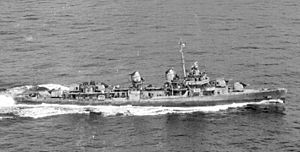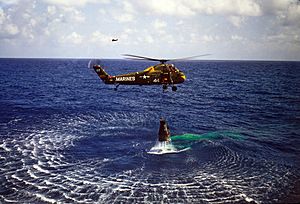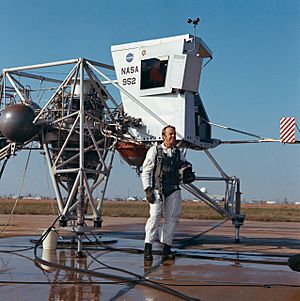Alan Shepard facts for kids
Quick facts for kids
Alan Shepard
|
|
|---|---|
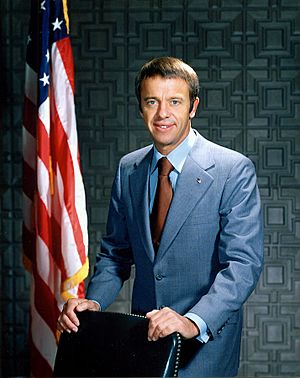
Shepard in 1971
|
|
| Born |
Alan Bartlett Shepard Jr.
November 18, 1923 Derry, New Hampshire, U.S.
|
| Died | July 21, 1998 (aged 74) Pebble Beach, California, U.S.
|
| Resting place | Ashes scattered in Stillwater Cove |
| Alma mater |
|
| Occupation | |
| Awards |
|
| Space career | |
| NASA astronaut | |
| Rank | Rear Admiral, United States Navy |
|
Time in space
|
9d 00h 57m |
| Selection | 1959 NASA Group 1 |
|
Total EVAs
|
2 |
|
Total EVA time
|
9 hours 23 minutes |
| Missions | |
|
Mission insignia
|
|
| Retirement | August 1, 1974 |
Alan Bartlett Shepard Jr. (born November 18, 1923 – died July 21, 1998) was an American astronaut, Navy pilot, test pilot, and businessman. In 1961, he became the second person and the first American to travel into space. Later, in 1971, he became the fifth person to walk on the Moon. At 47 years old, he was the oldest person to do so at that time.
Shepard graduated from the United States Naval Academy in Annapolis, Maryland. He served in the Navy during World War II. In 1946, he became a Navy pilot, and in 1950, a test pilot. He was chosen as one of the first NASA Mercury Seven astronauts in 1959. In May 1961, he made the first American crewed space flight, Mercury-Redstone 3, in his spacecraft named Freedom 7. His craft went into space but did not orbit Earth. He was the first space traveler to control his spacecraft manually.
Shepard was supposed to command the first crewed Project Gemini mission. However, he was grounded in October 1963 because of Ménière's disease. This inner-ear problem caused severe dizziness. After surgery corrected the issue in 1968, Shepard commanded the Apollo 14 mission in 1971. He piloted the Apollo Lunar Module Antares. At 47, he became the fifth person to walk on the Moon, and the only one of the original Mercury Seven astronauts to do so. During this mission, he famously hit two golf balls on the Moon's surface.
Shepard was the Chief of the Astronaut Office from November 1963 to August 1969. He held this role again from June 1971 until he retired from the United States Navy and NASA on August 1, 1974. He was promoted to rear admiral on August 25, 1971. He was the first astronaut to reach this high rank.
Contents
Early Life and Education
Alan Bartlett Shepard Jr. was born on November 18, 1923, in Derry, New Hampshire. His parents were Alan Bartlett Shepard Sr. and Pauline Renza Shepard. He had one younger sister named Pauline, or Polly.
Shepard was a bright student. He skipped the sixth and eighth grades. He also became a First Class Scout. In 1936, he attended Pinkerton Academy, a private school his father had also gone to. He loved flying and started a model airplane club there. In 1938, he got to fly in a real Douglas DC-3 plane as a Christmas gift. The next year, he often cycled to Manchester Airfield. He would do small jobs there to get occasional airplane rides or informal flying lessons.
Shepard finished Pinkerton Academy in 1940. With World War II happening in Europe, his father wanted him to join the Army. But Shepard chose the Navy instead. He passed the entrance exam for the United States Naval Academy in 1940. However, at 16, he was too young to join that year. The Navy sent him to the Admiral Farragut Academy, a special school for the Naval Academy. He graduated from there in 1941.
At Annapolis, Shepard enjoyed water sports. He was a very good sailor and won many races. He learned to sail all types of boats, including a large schooner. He also swam and rowed. Because of the war, his four-year course at Annapolis was shortened by a year. He graduated on June 6, 1944, and became an ensign. He also earned a Bachelor of Science degree.
In August 1944, Shepard was assigned to a destroyer, USS Cogswell. This was part of Navy policy for aviation students to first serve at sea. His ship was in the Pacific Ocean. Cogswell helped rescue sailors from another ship that was hit by a Japanese submarine. It also faced Typhoon Cobra and battled kamikazes during the invasion of Lingayen Gulf in January 1945.
Shepard married Louise Brewer on March 3, 1945. They later had two daughters, Laura and Julie. They also raised Louise's niece, Judith, as their own daughter.
On his second trip with Cogswell, Shepard was in charge of the anti-aircraft guns. They fought kamikazes in the Battle of Okinawa. His ship was a "radar picket," meaning it warned the fleet about incoming Japanese planes. This was a dangerous job, as they were often the first ships attacked. Cogswell also took part in bombing Japan. Shepard was in Tokyo Bay when Japan surrendered in September 1945.
In November 1945, Shepard began flight training in Texas. He was an average student at first. He even took private lessons to improve his skills. By early 1947, his instructors rated him above average. He then went to Naval Air Station Pensacola in Florida for advanced training. His final test was six perfect landings on the aircraft carrier USS Saipan. The next day, he earned his Navy pilot wings.
Shepard was assigned to Fighter Squadron 42 (VF-42), flying the Vought F4U Corsair. He went on his first cruise to the Caribbean in 1948. He also qualified for dangerous night landings on a carrier. After this, he went on a nine-month tour of the Mediterranean Sea.
In 1950, Shepard was chosen to attend the United States Naval Test Pilot School in Maryland. As a test pilot, he performed many important tests. These included high-altitude tests and checking new in-flight refueling systems. He also tested the new angled flight deck on aircraft carriers. He almost got into trouble for flying too low over the Chesapeake Bay Bridge and a beach, but his commanders helped him.
Shepard's next job was with VF-193, a night fighter squadron. He flew the McDonnell F2H Banshee. He served two tours on the aircraft carrier USS Oriskany in the western Pacific. In 1953, the ship was sent to Korea during the Korean War. However, the war ended before Shepard saw combat.
Shepard continued to test new aircraft. He tested the McDonnell F3H Demon, Vought F-8 Crusader, Douglas F4D Skyray, and Grumman F-11 Tiger. He had a close call when he had to eject from a Vought F7U Cutlass that went into an uncontrollable spin. In 1957, he tested the Douglas F5D Skylancer. He gave it a bad report, and the Navy canceled orders for it. He also had an engine failure during a high-speed dive in an F11F, but he managed to restart the engine and land safely.
Shepard became an instructor at the Test Pilot School. Then he attended the Naval War College. He graduated in 1957. By this time, he had flown more than 3,600 hours, with 1,700 hours in jets.
Becoming an Astronaut: The Mercury Seven

On October 4, 1957, the Soviet Union launched Sputnik 1, the first artificial satellite. This made Americans worried about their technology. To respond, President Dwight D. Eisenhower started the Space Race. The National Aeronautics and Space Administration (NASA) was created on October 1, 1958. It was a civilian agency to develop space technology. One of its first big projects was Project Mercury. Its goal was to send a person into Earth orbit, bring them back safely, and see what they could do in space.
NASA was allowed to choose its first astronauts from military test pilots. They looked at the records of 508 pilots. They narrowed it down to 110 who met the basic rules: younger than 40, a college degree, and 5 feet 11 inches tall or less. The height rule was very strict because of the small size of the Mercury spacecraft.
Shepard was in the first group of 35 pilots who met with NASA in February 1959. Navy and Marine Corps officers were welcomed by Admiral Arleigh Burke. Air Force officers met with General Thomas D. White. Both leaders promised to support the space program. NASA officials explained that Project Mercury would be dangerous but very important for the country. Shepard and other pilots decided to volunteer.
After many tests, NASA chose seven astronauts instead of the planned six. Shepard was told he was selected on April 1, 1959. The names of the seven astronauts were announced on April 9, 1959: Scott Carpenter, Gordon Cooper, John Glenn, Gus Grissom, Wally Schirra, Alan Shepard, and Deke Slayton. A few weeks later, they watched their first rocket launch, an SM-65D Atlas. It exploded a few minutes after liftoff. Shepard joked, "Well, I'm glad they got that out of the way."
First American in Space: Freedom 7
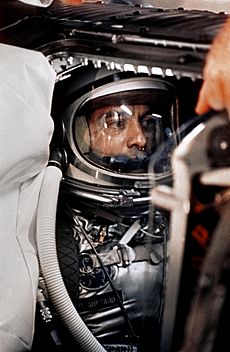
Shepard worked hard and competed with the other astronauts. On January 19, 1961, he was chosen for the first American crewed space mission. He later joked that his wife, Louise, asked, "Who let a Russian in here?" when he told her he would be the first American in space. He practiced 120 simulated flights.
The flight was delayed many times. On April 12, 1961, Soviet cosmonaut Yuri Gagarin became the first person in space and the first to orbit Earth. This was a big blow to American pride. Shepard was very upset when he heard the news.
On May 5, 1961, Shepard piloted the Mercury-Redstone 3 mission. He became the second person and the first American to travel into space. He named his spacecraft Freedom 7. He woke up early, had breakfast, and got into his space suit. He entered the spacecraft at 5:20 AM. There were many delays, and he was in his suit for over four hours. He had a small accident in his suit because of the long wait. After his flight, the space suit was changed to include a way to collect liquid waste.
Shepard's flight was a short, 15-minute suborbital trip. It reached an altitude of about 101 nautical miles (187 km). Then it splashed down about 263 nautical miles (487 km) away in the Atlantic Missile Range. Unlike Gagarin's flight, which was fully automatic, Shepard could control Freedom 7's direction. Millions of people watched his launch live on television. It was launched on a Redstone rocket.
After a successful landing in the Atlantic Ocean, a helicopter quickly picked up Shepard and his capsule. The whole rescue took only eleven minutes. Shepard became a national hero. He had parades in Washington, New York, and Los Angeles. President John F. Kennedy gave him the NASA Distinguished Service Medal. He also received the Distinguished Flying Cross.
Shepard helped with other Mercury missions. He was the capsule communicator (CAPCOM) for John Glenn's orbital flight. He was also the backup pilot for Gordon Cooper's mission. Shepard was supposed to pilot the Mercury-Atlas 10 mission, a three-day flight. He named his spacecraft Freedom 7 II. But on June 12, 1963, NASA decided that Project Mercury had met its goals, and no more missions would fly. Shepard even asked President Kennedy to change his mind, but it didn't work.
Chief Astronaut and Apollo 14 Mission
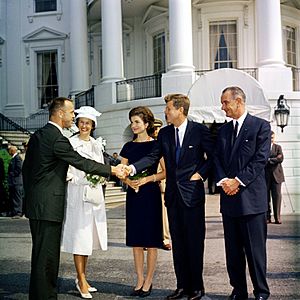
After the Mercury-Atlas 10 mission was canceled, Shepard was chosen to command the first crewed Project Gemini mission. Thomas P. Stafford was selected as his pilot. But in late 1963, Shepard started having severe dizziness and nausea. He tried to keep it a secret, fearing he would lose his flight status. But he knew it could be dangerous if it happened during a flight. He eventually told Deke Slayton, who was in charge of flight operations.
Doctors diagnosed him with Ménière's disease. This condition causes fluid pressure to build up in the inner ear, leading to dizziness and disorientation. There was no known cure at the time. This meant Shepard could no longer fly. Gus Grissom and John Young flew Gemini 3 instead.
Shepard became the Chief of the Astronaut Office in November 1963. This meant he was in charge of training all NASA astronauts. He helped create training programs and scheduled astronauts for specific missions. He also gave advice on spacecraft design. He spent a lot of his time investing in banks and real estate. His secretary, Gaye Alford, had two photos of Shepard: "Smilin' Al" and "Icy Commander." She would hang the right photo on his door to show his mood.
In 1968, Shepard learned about a new surgery for Ménière's disease. He had the surgery on May 14, 1968. It was successful, and he was cleared to fly again on May 7, 1969.
Slayton assigned Shepard to command the next available Moon mission, Apollo 13. However, NASA officials thought Shepard's crew was too new to Apollo missions. So, Jim Lovell's crew, who were scheduled for Apollo 14, took over Apollo 13. Shepard's crew was then assigned to Apollo 14.
Apollo 13 had a serious problem: an oxygen tank exploded. The Moon landing was canceled, and the crew almost didn't make it back. This delayed Apollo 14 until 1971. The target for Apollo 14 was changed to the Fra Mauro formation, which was Apollo 13's original destination.
Shepard made his second space flight as commander of Apollo 14 from January 31 to February 9, 1971. It was America's third successful Moon landing mission. Shepard piloted the Lunar Module Antares. He became the fifth person to walk on the Moon. At 47, he was the oldest person to do so, and the only one of the original Mercury Seven astronauts to achieve this.
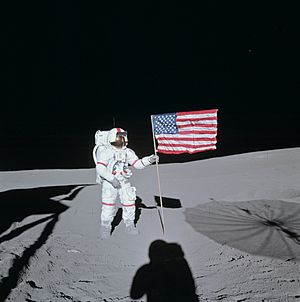
This mission was the first to broadcast a lot of color television from the Moon's surface. While on the Moon, Shepard used a golf club head attached to a lunar sample scoop handle. He hit two golf balls. Even with thick gloves and a stiff spacesuit, he managed to hit the second ball, jokingly saying it went "miles and miles and miles." Experts later estimated the second shot went about 40 yards (37 meters).
For this mission, Shepard received the NASA Distinguished Service Medal and the Navy Distinguished Service Medal.
After Apollo 14, Shepard returned to his role as Chief of the Astronaut Office in June 1971. President Richard Nixon appointed him as a delegate to the United Nations General Assembly in 1971. He was promoted to rear admiral by Nixon on August 26, 1971. He was the first astronaut to reach this rank. He retired from NASA and the Navy on July 31, 1974.
Later Years and Legacy
Shepard was very dedicated to his children and grandchildren. He taught them to ski and took them on trips. After Apollo 14, he spent more time with his wife, Louise.
After leaving NASA, Shepard served on the boards of many companies. He also led his own business, Seven Fourteen Enterprises, Inc. (named after his two flights: Freedom 7 and Apollo 14). He made a lot of money in banking and real estate.
In 1984, Shepard and the other surviving Mercury astronauts, along with Gus Grissom's widow, founded the Mercury Seven Foundation. This foundation raises money for college scholarships for science and engineering students. It was renamed the Astronaut Scholarship Foundation in 1995. Shepard was its first president and chairman until 1997. His daughter Laura Churchley now leads the foundation's Board of Trustees.
In 1994, Shepard published a book called Moon Shot: The Inside Story of America's Race to the Moon with journalists Jay Barbree and Howard Benedict. The book was later made into a TV miniseries.
Shepard was diagnosed with chronic lymphocytic leukemia in 1996. He died from complications of the disease on July 21, 1998, in Pebble Beach, California. His wife, Louise, died a month later, on August 25, 1998. They had been married for 53 years. Their family decided to cremate them both. Their ashes were scattered together from a Navy helicopter over Stillwater Cove, near their home.
On December 11, 2021, Shepard's daughter Laura Shepard Churchley flew into space herself. She was aboard Blue Origin's New Shepard 5 spaceship.
Awards and Honors
Shepard received the Congressional Space Medal of Honor from President Jimmy Carter on October 1, 1978. He also received many other awards, including the Golden Plate Award in 1981 and the Langley Gold Medal in 1964. He was given honorary degrees from several universities. He was inducted into the National Aviation Hall of Fame in 1977, the International Space Hall of Fame in 1981, and the U.S. Astronaut Hall of Fame on May 11, 1990.
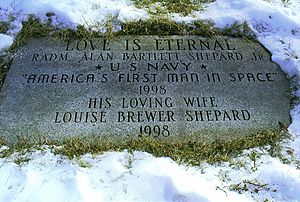
The Navy named a supply ship, USNS Alan Shepard (T-AKE-3), after him in 2006. The McAuliffe-Shepard Discovery Center in Concord, New Hampshire, is named after Shepard and Christa McAuliffe. A highway in Alabama, I-565, is called the "Admiral Alan B. Shepard Highway." Interstate 93 in New Hampshire is also named the Alan B. Shepard Highway. His hometown of Derry is nicknamed Space Town because of his astronaut career. The post office in Derry is named the Alan B. Shepard Jr. Post Office Building. Alan Shepard Park in Cocoa Beach, Florida, is also named in his honor.
Shepard's high school, Pinkerton Academy, has a building named after him. Their sports team is called the Astros. Alan B. Shepard High School in Palos Heights, Illinois, which opened in 1976, was named in his honor. The school newspaper is named Freedom 7, and the yearbook is called Odyssey. Blue Origin's suborbital space tourism rocket, the New Shepard, is named after him.
In a 2010 survey, Shepard was ranked as the ninth most popular space hero. In 2011, NASA honored him with an Ambassador of Exploration Award, which included a Moon rock. The U.S. Postal Service issued a first-class stamp in Shepard's honor in 2011.
Each year, the Space Foundation gives the Alan Shepard Technology in Education Award. This award recognizes teachers and school leaders who make great contributions to educational technology.
In Media
- 1965 British TV series Thunderbirds – the character of Alan Tracy was named after him.
- 1983 film The Right Stuff – played by Scott Glenn.
- 1998 HBO miniseries From the Earth to the Moon – played by Ted Levine.
- 2001 opening montage, Star Trek: Enterprise.
- 2002 film Race to Space – played by Mark Moses.
- 2005 BBC TV series Space Race – played by Todd Boyce.
- 2007–2012 BioWare video game series Mass Effect – main protagonist Commander Shepard is named after him.
- 2015 ABC TV series The Astronaut Wives Club – played by Desmond Harrington.
- 2016 film Hidden Figures – played by Dane Davenport.
- 2020 Disney+ TV Series The Right Stuff – played by Jake McDorman.
Images for kids
See also
 In Spanish: Alan Shepard para niños
In Spanish: Alan Shepard para niños


